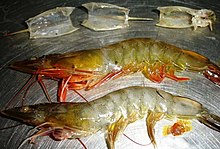Whiteleg shrimp
| Litopenaeus vannamei | |
|---|---|
 |
|
| Scientific classification | |
| Kingdom: | Animalia |
| Phylum: | Arthropoda |
| Subphylum: | Crustacea |
| Class: | Malacostraca |
| Order: | Decapoda |
| Suborder: | Dendrobranchiata |
| Family: | Penaeidae |
| Genus: | Litopenaeus |
| Species: | L. vannamei |
| Binomial name | |
|
Litopenaeus vannamei (Boone, 1931) |
|
| Synonyms | |
|
Penaeus vannamei Boone, 1931 |
|
| External identifiers for Whiteleg shrimp | |
|---|---|
| Encyclopedia of Life | 1036948 |
| ITIS | 551682 |
| NCBI | 6689 |
| WoRMS | 247789 |
Penaeus vannamei Boone, 1931
Whiteleg shrimp (Litopenaeus vannamei, formerly Penaeus vannamei), also known as Pacific white shrimp, King prawn, is a variety of prawn of the eastern Pacific Ocean commonly caught or farmed for food.
Litopenaeus vannamei grows to a maximum length of 230 millimetres (9.1 in), with a carapace length of 90 mm (3.5 in). Adults live in the ocean, at depths of up to 72 metres (236 ft), while juveniles live in estuaries. The rostrum is moderately long, with 7–10 teeth on the dorsal side and 2–4 teeth on the ventral side.
Whiteleg shrimp are native to the eastern Pacific Ocean, from the Mexican state of Sonora as far south as northern Peru. It is restricted to areas where the water temperature remains above 20 °C (68 °F) throughout the year.
During the 20th century, L. vannamei was an important species for Mexican inshore fishermen, as well as for trawlers further offshore. In the late 20th century, the wild fishery was overtaken by the use of aquaculture; this began in 1973 in Florida using prawns captured in Panama. In Latin America, the culture of L. vannamei showed peaks of production during the warm El Niño years, and reduced production during the cooler La Niña years, due to the effects of disease. Production of L. vannamei is limited by its susceptibility to various diseases, including white spot syndrome, Taura syndrome, infectious hypodermal and haematopoietic necrosis, baculoviral midgut gland necrosis and Vibrio infections. By 2004, global production of L. vannamei approached 1,116,000 t, and exceeded that of Penaeus monodon.
...
Wikipedia
